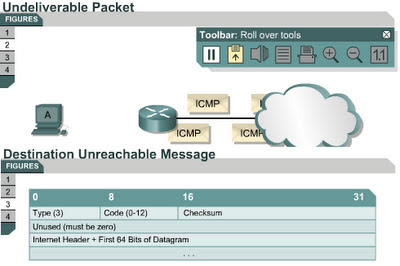Address mask requests
8.2.5 This page will explain address mask request messages and how they are used.
When a network administrator uses the process of subnetting to divide a major IP address into multiple subnets, a new subnet mask is created. This new subnet mask is important to identify network, subnet, and host bits in an IP address. If a host does not know the subnet mask, it may send an address mask request to the local router. If the address of the router is known, this request may be sent directly to the router. Otherwise, the request will be broadcast. When the router receives the request, it will respond with an address mask reply. This address mask reply will identify the correct subnet mask. For example, assume that a host is located within a Class B network and has an IP address of 172.16.5.2. This host does not know the subnet mask so it broadcasts an address mask request:
Source address: 172.16.5.2
Destination address: 255.255.255.255
Protocol: ICMP = 1
Type: Address Mask Request = AM1
Code: 0
Mask: 255.255.255.0
This broadcast is received by 172.16.5.1, the local router. The router responds with the address mask reply:
Source address: 172.16.5.1
Destination address: 172.16.5.2
Protocol: ICMP = 1
Type: Address Mask Reply = AM2
Code: 0
Mask: 255.255.255.0
The frame format for the address mask request and reply is shown in Figure . Figure
. Figure  shows the descriptions for each field in the address mask request message. Note that the same frame format is used for both the address mask request and the reply. However, an ICMP type number of 17 is assigned to the request and 18 is assigned to the reply.
shows the descriptions for each field in the address mask request message. Note that the same frame format is used for both the address mask request and the reply. However, an ICMP type number of 17 is assigned to the request and 18 is assigned to the reply.
The next page will introduce the ICMP router discovery message.
8.2.5 This page will explain address mask request messages and how they are used.
When a network administrator uses the process of subnetting to divide a major IP address into multiple subnets, a new subnet mask is created. This new subnet mask is important to identify network, subnet, and host bits in an IP address. If a host does not know the subnet mask, it may send an address mask request to the local router. If the address of the router is known, this request may be sent directly to the router. Otherwise, the request will be broadcast. When the router receives the request, it will respond with an address mask reply. This address mask reply will identify the correct subnet mask. For example, assume that a host is located within a Class B network and has an IP address of 172.16.5.2. This host does not know the subnet mask so it broadcasts an address mask request:
Source address: 172.16.5.2
Destination address: 255.255.255.255
Protocol: ICMP = 1
Type: Address Mask Request = AM1
Code: 0
Mask: 255.255.255.0
This broadcast is received by 172.16.5.1, the local router. The router responds with the address mask reply:
Source address: 172.16.5.1
Destination address: 172.16.5.2
Protocol: ICMP = 1
Type: Address Mask Reply = AM2
Code: 0
Mask: 255.255.255.0
The frame format for the address mask request and reply is shown in Figure
The next page will introduce the ICMP router discovery message.





